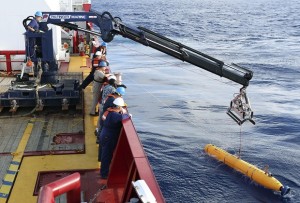
In this Monday, April 14, 2014, photo provided by the Australian Defense Force an autonomous underwater vehicle is deployed from ADV Ocean Shield in the search of the missing Malaysia Airlines Flight 370 in the southern Indian Ocean. The search area for the missing Malaysian jet has proved too deep for the robotic submarine which was hauled back to the surface of the Indian Ocean less than half way through its first seabed hunt for wreckage and the all-important black boxes, authorities said on Tuesday. AP/Australian Defense Force, Lt. Kelli Lunt FILE PHOTO
CANBERRA – Officials Monday said it could be up to two months before new, more sophisticated equipment will be in the water to help the search for flight MH370 across what will be largely unmapped ocean floor.
The hunt for the missing Malaysia Airlines plane that disappeared on March 8 carrying 239 people was scaled back last week after coming up with nothing, despite an air and sea search of 4.64 million square kilometres of the southern Indian Ocean.
Australia on Monday hosted a meeting in Canberra with the transport ministers of Malaysia and China to determine the way forward, which will focus on an intensified undersea search.
China is involved because two-thirds of the passengers were Chinese, while the plane is believed to have gone down in Australia’s search and rescue territory.
Australian Deputy Prime Minister Warren Truss admitted the hunt will take time, with the ocean bed in the prospective search zone several kilometres deep and largely unmapped, meaning specialist sonar equipment and other autonomous vehicles are needed.
He said a tender process would start soon to acquire them, but it would likely be two months before the equipment was actually in the water, while more oceanographic mapping was required to better understand where they would be looking.
“We are optimistic that we can do most of this in the space of one to two months so we will actually have more hardware in the water within a couple of months,” he said after meeting Malaysian Transport Minister Hishammuddin Hussein and Chinese counterpart Yang Chuantang.
“In the interim we’ll still have the Bluefin-21 working and we’ll get going on the oceanographic work that needs to be done so they’ll be no long interruptions in this search.”
A submersible Bluefin-21 has been scouring the seabed in an area where undersea transmissions were detected, believed to have come from the plane’s black box flight recorders before their batteries died.
It was due back in Perth with the Australian navy vessel Ocean Shield on Monday for maintenance and software modifications before returning to the search zone.
Once back in the Indian Ocean it will be joined by a dedicated team of vessels from Australia, Malaysia and China. An Australian P-3 Orion jet will also be available to follow-up any leads.
Truss added that international experts will from Wednesday begin re-examining satellite imagery and all the data collated so far, while the Joint Agency Coordinating Centre, which has been organising the search, will be moved from Perth to Canberra.
He refused to put a time frame on when the plane might be found.
“We obviously have no idea when it’s likely to be found, we just always hope it is tomorrow,” he said.
“But so far our very, very best leads, and on days when we were quite confident that it was going to be the day, have all proved fruitless so it would be unduly optimistic to name a day or time.”